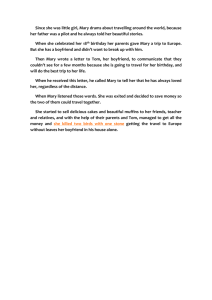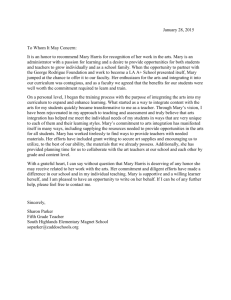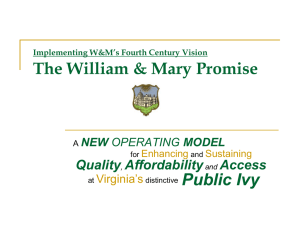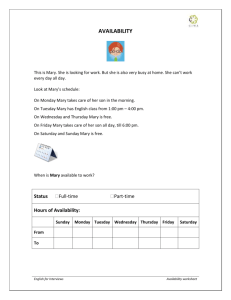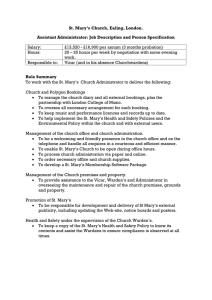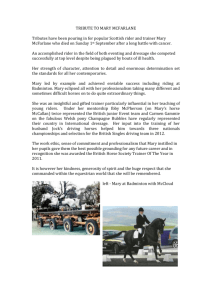college of william & mary - State Council of Higher Education for
advertisement
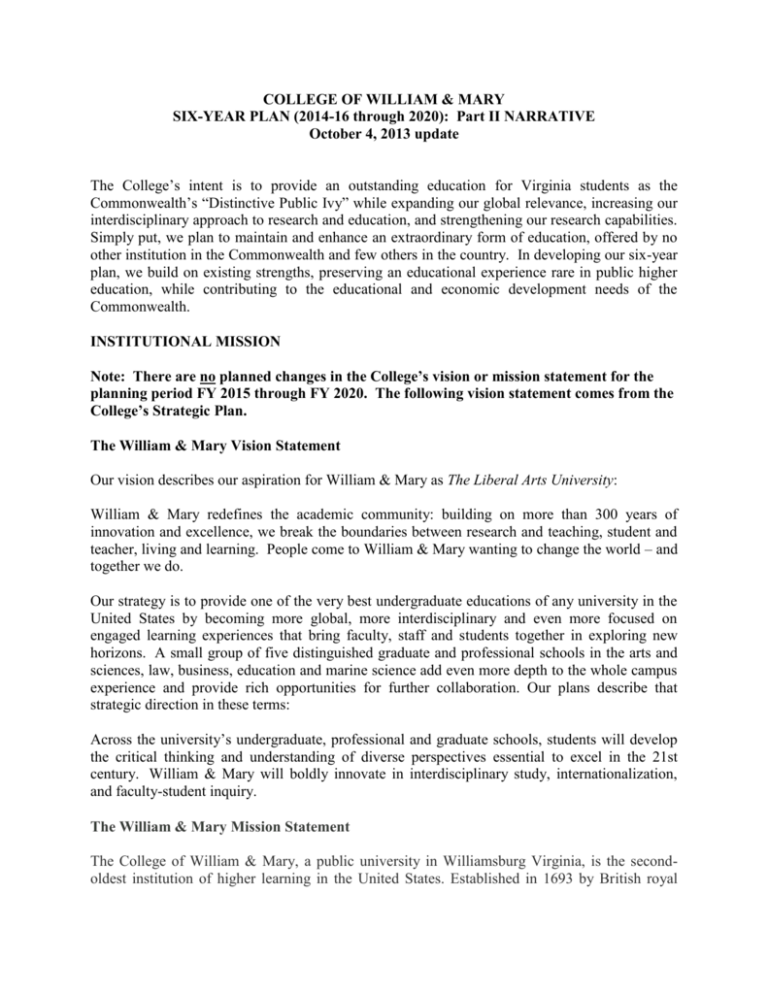
COLLEGE OF WILLIAM & MARY SIX-YEAR PLAN (2014-16 through 2020): Part II NARRATIVE October 4, 2013 update The College’s intent is to provide an outstanding education for Virginia students as the Commonwealth’s “Distinctive Public Ivy” while expanding our global relevance, increasing our interdisciplinary approach to research and education, and strengthening our research capabilities. Simply put, we plan to maintain and enhance an extraordinary form of education, offered by no other institution in the Commonwealth and few others in the country. In developing our six-year plan, we build on existing strengths, preserving an educational experience rare in public higher education, while contributing to the educational and economic development needs of the Commonwealth. INSTITUTIONAL MISSION Note: There are no planned changes in the College’s vision or mission statement for the planning period FY 2015 through FY 2020. The following vision statement comes from the College’s Strategic Plan. The William & Mary Vision Statement Our vision describes our aspiration for William & Mary as The Liberal Arts University: William & Mary redefines the academic community: building on more than 300 years of innovation and excellence, we break the boundaries between research and teaching, student and teacher, living and learning. People come to William & Mary wanting to change the world – and together we do. Our strategy is to provide one of the very best undergraduate educations of any university in the United States by becoming more global, more interdisciplinary and even more focused on engaged learning experiences that bring faculty, staff and students together in exploring new horizons. A small group of five distinguished graduate and professional schools in the arts and sciences, law, business, education and marine science add even more depth to the whole campus experience and provide rich opportunities for further collaboration. Our plans describe that strategic direction in these terms: Across the university’s undergraduate, professional and graduate schools, students will develop the critical thinking and understanding of diverse perspectives essential to excel in the 21st century. William & Mary will boldly innovate in interdisciplinary study, internationalization, and faculty-student inquiry. The William & Mary Mission Statement The College of William & Mary, a public university in Williamsburg Virginia, is the secondoldest institution of higher learning in the United States. Established in 1693 by British royal charter, William & Mary is proud of its role as the alma mater of generations of American patriots, leaders and public servants. Now, in its fourth century, it continues this tradition of excellence by combining the best features of an undergraduate college with the opportunities offered by a modern research university. Its moderate size, dedicated faculty, and distinctive history give William & Mary a unique character among public institutions, and create a learning environment that fosters close interaction among students and teachers. The university's predominantly residential undergraduate program provides a broad liberal education in a stimulating academic environment enhanced by a talented and diverse student body. This nationally acclaimed undergraduate program is integrated with selected graduate and professional programs in five faculties -- Arts and Sciences, Business, Education, Law, and Marine Science. Master’s and doctoral programs in the humanities, the sciences, the social sciences, business, education, and law provide a wide variety of intellectual opportunities for students at both graduate and undergraduate levels. At William & Mary, teaching, research, and public service are linked through programs designed to preserve, transmit, and expand knowledge. Effective teaching imparts knowledge and encourages the intellectual development of both student and teacher. Quality research supports the educational program by introducing students to the challenge and excitement of original discovery, and is a source of the knowledge and understanding needed for a better society. The university recognizes its special responsibility to the citizens of Virginia through public and community service to the Commonwealth as well as to national and international communities. Teaching, research, and public service are all integral parts of the mission of William & Mary. Goals In fulfilling its mission, William & Mary adopts the following specific goals: to attract outstanding students from diverse backgrounds; to develop a diverse faculty which is nationally and internationally recognized for excellence in both teaching and research; to provide a challenging undergraduate program with a liberal arts and sciences curriculum that encourages creativity, independent thought, and intellectual depth, breadth, and curiosity; to offer high quality graduate and professional programs that prepare students for intellectual, professional, and public leadership; to instill in its students an appreciation for the human condition, a concern for the public well-being, and a life-long commitment to learning; and to use the scholarship and skills of its faculty and students to further human knowledge and understanding, and to address specific problems confronting the Commonwealth of Virginia, the nation, and the world. ACADEMIC EXCELLENCE, FINANCIAL SOUNDNESS AND THE SIX-YEAR PLAN Each fall, public institutions of higher education in Virginia are required by the Higher Education Opportunity Act of 2011 (TJ21) to submit updated six-year plans to the Commonwealth. The plans identify critical needs and priorities as well as expenditures and planned resources. William & Mary’s plan, first adopted by the Board of Visitors in September 2011, was informed by both the goals of the TJ21 legislation and the ongoing strategic planning effort that began in 2008. A primary objective of the plan is to continue the excellence of W&M’s “public ivy” education. In order to do so, we must narrow the gap between quality and the resources the College has to sustain that quality. According to U.S. News, the gap between William & Mary’s academic quality and the university’s financial resources is unparalleled: W&M ranks 33rd in the nation in quality and 112th in resources. No other university in the top 50 has a gap anywhere close to the 79-point difference of those two rankings, and this gap has been growing significantly over the last three years. Insert Gap Chart Retaining and attracting top faculty – the lifeblood of any great university, especially a “public ivy” – is exceptionally difficult when the resource gap becomes so wide. W&M’s faculty salaries have declined significantly relative to its peer institutions as identified by the State Council of Higher Education for Virginia (SCHEV). The TJ21 legislation enacted just two years ago reiterated the Commonwealth’s longstanding goal of having its colleges and universities provide faculty salaries at the 60th percentile of their SCHEV-identified peers. The College new operating model (William & Mary Promise) will provide resources to help the College reverse the negative current trend and move, based on merit, toward the 60th percentile endorsed by TJ21.. While the Governor and General Assembly in recent years commendably have halted and begun to reverse the decade-long state disinvestment in higher education documented by the Governor’s Commission on Higher Education Reform, Innovation and Investment, the uncertain economy and long-term fiscal constraints suggest that reinvestment by the Commonwealth will be limited and targeted. The new operating model thus relies on a combination of sources within the College’s control – savings from even greater productivity, efficiency, and innovation, increased private philanthropy and higher net tuition revenues – with the result that instructional quality is preserved and enhanced while extending affordable access to many more deserving Virginia students, especially those caught in the “middle class squeeze.” PROGRESS MADE THROUGH PRIOR STRATEGIES The 2012-14 biennium included implementation of the six-year plan process required by TJ21. This process required the College to develop both academic and financial plans for FY 2013 through 2018 with a primary focus on 2012-2014. While many of the elements of that initial plan continue to be reflected in this submission, highlights of progress made on existing strategies include the following: Faculty salaries—Supplementing bonus and base funding for salaries provided by the Commonwealth, the College’s Board of Visitors authorized base salary increases for faculty of 2% in FY 2013 and 6% in FY 2014. The intent of this action was to improve the College’s competitive position for faculty and, over time, reach the 60th percentile among its state-approved peer group. Undergraduate financial aid—On April 19, 2013, William & Mary’s Board of Visitors approved “The William & Mary Promise,” a new operating model that provides vitally needed resources to secure the future of Virginia’s distinctive “public ivy” while markedly enhancing predictability, affordability and access for Virginia students. A more detailed description of the William & Mary Promise is included in the proposed strategies for the 2014-2016 biennium. Undergraduate enrollment growth—The College continued to meet its commitment to grow in-state undergraduate enrollment by 150 over four years with the first cohort arriving in Fall, 2011. The College’s enrollment projections reflect this commitment as well as further growth anticipated as part of the William & Mary Promise. Marine Science Minor—In cooperation with the Virginia Institute of Marine Science, the College fully implemented the marine science minor in support of expanding opportunities for STEM education. The College continues to aggressively recruit high school students interested in the STEM-H disciplines. Graduate financial aid—The College continued to increase its support for graduate financial aid, particularly in the STEM disciplines. New investment totaled $850,000 over the 2012-2014 biennium. Commonwealth Center for Energy and the Environment—Using reallocated funds, the CCEE funded three proposals in FY 2013 and is actively soliciting proposals for FY 2014. Each proposal identified areas of significant opportunity, cultivating the formation of interdisciplinary groups around a core innovative concept, and supporting the working groups necessary to execute large scale research efforts. Funded proposals included o o o Unnatural Disaster: Coastal Flooding, Sea Level Rise, And Environmental Justice In Virginia’s Tidewater Region. This proposal examines how coastal flooding and sea level rise exposes social vulnerability and raises questions of environmental justice in Virginia’s Tidewater Region. Sea Level Rise and Storm Surge Adaptation. This proposal builds on an award winning, innovative storm surge model developed at VIMS. This model forms the basis for a broader interdisciplinary research based in VIMS and the W&M Center for Geospatial Analysis that will produce scenarios detailing the vulnerabilities and impacts of future storms on critical infrastructure in the Chesapeake Region. Feasibility Study for Developing a Critical Zone Observatory (CZO) Focused on EnergyRelated Pollutants in Coastal Plain Watersheds. This proposal highlights an important feature of the CCEE’s role in providing small grants to support the planning, strategy and initial phase contacts with funding agencies. The developmental group will assess the feasibility of developing an NSF-funded Critical Zone Observatory (CZO) site in the Virginia Coastal Plain focusing on the cycling of energy-related pollutants through forested and developed watersheds in the Coastal Plain. Internationalization—William & Mary is quickly emerging as a global leader among liberal arts universities. Beyond the fact that the College ranks consistently #1 or #2 among public universities in the percentage of students that study abroad, the College has launched a series of high-profile and successful international initiatives that reach across all our academic and administrative units. These include the William & Mary Confucius Institute; the St. Andrews Joint Degree Program; the SECON (Social Entrepreneurship Conference) Program in the Mason School; the Indian Ocean Initiative supporting new ties between W&M and India, the Sultanate of Oman, and the larger Indian Ocean basin; and the AidData Center for Development Policy, which recently won a highly competitive $25 million award from the U.S. Agency for International Development. We currently enroll an international community of students and scholars numbering over 600 people. Collaboration with EVMS—The College began to investigate potential collaboration with Eastern Virginia Medical School (EVMS). In Fall 2012, health care delivery science (HCDS) was identified as a promising area for cross-institutional research and educational programs and this area has been expanded to include health services research. Health services research includes various social science disciplines as well as the types of research carried out under the HCDS heading. Using funds appropriated by the Commonwealth and a contribution from Sentara, we are now beginning to engage researchers across both institutions through a series of faculty retreats and seminars as well as funding small grants in support of collaborative research. 2014-2020 STRATEGIES (expanded narratives) The following narratives support the various strategies included in the College’s academic and financial plan. Priority 1—William & Mary Promise (mitigate impact of tuition and fee increases on lowand middle income students and their families, while continuing W&M’s “public Ivy” education) On April 19, 2013, William & Mary’s Board of Visitors approved “The William & Mary Promise,” a new operating model that provides vitally needed resources to secure the future of Virginia’s distinctive “public ivy” while markedly enhancing predictability, affordability and access for Virginia students. Elements of the Promise include: Predictability: Four-year tuition guarantee: Provides Virginia families with financial predictability through a commitment to incoming in-state students that tuition will remain constant through all four years of their undergraduate study. Beginning Fall 2013, entering Virginia students will know exactly what their tuition costs will be for all four years at William & Mary, and those costs will not rise from year to year. In April, 2013, the Board of Visitors set tuition for classes entering in the fall of 2013, 2014 and 2015. Virginia undergraduate students in each entering class will see a one-time step increase their freshman year: to $10,428 for the 2013-14 academic year, $12,428 for 2014-2015, and $13,978 for 2015-2016. For each entering class, tuition will be frozen at that level for all four years. Tuition capped at CPI for returning Virginia undergraduates: For in-state undergraduate students enrolled at William & Mary before adoption of the new model, annual tuition increases will be held to no greater than the rate of inflation. Affordability: Relief for middle-income families: Reduces the “net tuition” paid by middle-income families, as defined by the state’s Higher Education Advisory Committee (HEAC). More than 70% of Virginia households qualify as “middle income” under the HEAC definition. Under the William & Mary Promise, students from middle-income families who qualify for need-based financial aid will pay no more “net tuition” (tuition less financial aid) than under the current model. Under this new model the College will increase the amount of need-based financial aid it provides to in-state students by 50 percent over the four-year period. Most of the increased aid will be used to provide grants in lieu of loans, thereby reducing student debt. Less debt for W&M graduates: Reduces by up to $8,000 the loan burden for middleincome in-state undergraduate students who have demonstrated financial need. The William & Mary Promise will lower the average annual borrowing and four-year cumulative debt average for Virginia undergraduates with demonstrated need as determined by the financial aid office. The plan will lower the maximum amount of loans included with an in-state financial aid package by 36% ($2,000 annually) for families with an income between $40,000 and $60,000, and by 18% ($1,000 annually) for all other families with demonstrated financial need. Students from Virginia families with a household income of less than $40,000 will continue to receive financial aid that covers 100% of their need with grants. As noted above, the definition of “middle income” used in the William & Mary Promise encompasses more than 70% of Virginia households and reflects the recommendation of the Higher Education Advisory Committee established under TJ21. As adopted by the General Assembly, TJ21 stressed the need to improve middle-income affordability and directed the Higher Education Advisory Committee to provide a definition of the target group. The Committee has done so, defining “middle income” as extending to 400% of the federal “poverty” definition, or to roughly $100,000 in annual income for a family of four with two children. Accessibility: Additional Virginia students: Provides for 150 additional in-state students to be enrolled to William & Mary over the next four years, which combined with the 2010 commitment of 150 in-state students represents an 8% increase since 2010. The William & Mary Promise ensures that all Virginia students, regardless of income or financial aid eligibility, will continue to receive a “public ivy” education at William & Mary for less than it actually costs the College to provide that education. Even after the step increases in tuition are fully implemented, William & Mary as a public university will still be subsidizing the education of all in-state students, even those whose family incomes and assets make them ineligible for financial aid. Under the William & Mary Promise, however, “middle-income” families will receive a larger share of this subsidy than under the current model. When the effects of increased financial aid are factored in, the "net tuition" paid by the vast majority of students who qualify for financial aid will be significantly lower. Priority 2—Increase Faculty Salaries This six-year plan continues the College’s commitment to achieving average faculty salaries of at least the 60th percentile among SCHEV-approved peer institutions and maintaining competitive salaries for administrative, professional and support staff. As a result, the plan assumes a 6% annual average increase in faculty salaries and a 4% annual increase for all other full-time staff. To the extent allowed by the Commonwealth, all increases will be merited based. Priority 3—Increase Staff Salaries This six-year plan continues the College’s commitment to provide competitive salaries to its administrative, professional and support staff (classified and operational). To the extent allowed by the Commonwealth, all salaries increases will be merit based within market-based pay bands. Priority 4—Undergraduate Enrollment FY 2014 is the third year of the College’s commitment to increase its overall in-state undergraduate enrollment by 150 students over four years. The university remains on track to meet this commitment. The William and Mary Promise commits to increasing overall in-state undergraduate enrollment by an additional 150 students over the 2015-2018 period. This is in addition to the 150 in-state seats the College has been phasing in since 2010. When completely phased in, W&M will have added an additional 300 spots for Virginia students compared to the 2010 enrollment—an increase of about 8%. Priority 5—Internationalization of Curriculum The College’s updated strategic plan includes internationalization as a primary area of opportunity over the planning period. Building on recent successes, the College is in the position to advance our global reputation, launch opportunities for international teaching and research, and attract new funding streams in support of our international work from private donors, corporate/foundation sources, and foreign governments. Effective internationalization demands a comprehensive approach that recognizes the campus-wide impacts of globalization. William & Mary is rare among universities in our ability to integrate deep cultural understanding, cutting-edge scientific analysis, and an abiding concern for policy relevance into a powerful new synthetic approach to international affairs. While other universities struggle to rethink and reorganize outmoded models for international administration, research, and teaching, W&M already has in place an innovative and streamlined organizational model for the management of globalization through its Reves Center. The Six-Year Plan includes funding over the 2014-16 biennium to support the phase-in of four internationally-focused teaching fellows and two internationally-focused post-docs, non-tenure track (NTE) term positions strategically placed across campus to meet the instructional needs of our students. NTE faculty provides maximum teaching effort while the term nature of the appointments allow for resources to be shifted among disciplines or to be interdisciplinary as necessary. Priority 6—eLearning Platform Using a combination of incremental and reallocated funds the College is moving forward to establish the necessary eLearning platform to support blended and on-line instruction. After review, the College determined that eLearning opportunities exist to: 1. Expand eLearning options in selected programs in the professional schools and graduate programs; 2. Identify high-quality, extant digital educational resources that can be used in William & Mary courses; and, 3. Expand “extension” activities and programming, providing ongoing learning opportunities for community members. Priority 7—Graduate Financial Aid This plan continues to expand support for graduate financial aid, particularly in STEM disciplines, in order to maintain the quality, and increase the number, of graduate students supporting research and undergraduate instruction in these areas. Priority 8—Creative Adaptation Fund This plan continues to encourage and support creative adaptation across the academic enterprise using both incremental and reallocated funds. As the scale of projects increases additional investment may be required to fully implement pilot projects. A more detailed discussion of creative adaptation and projects supported to date follows in the section “New Programs and Initiatives including Quality Improvements”. Priority 9—Base Operations The College will continue to allocate non-personnel support to selected areas as necessary to support academic, academic support, student service, administrative and plant operations. These allocations recognize the impact of prior budget reductions and inflation on units ability to provide quality, efficient and effective service. Priority 10—Risk Management/Radiation and Lab Safety The College’s on-going evaluation of risk across the institutions has determined that it should devote additional resources to monitoring the use of radiation and other dangerous substances in instructional and research setting. This expanded effort would supplement existing faculty, staff, and student training in these areas. Priority 11—Library Enhancement This item provides additional funds to support the purchase of digital materials with an emphasis on STEM-H journals and other materials. If the Commonwealth provides additional funding to VIVA for this purpose then specific funding to the College is not necessary. Priority 12—William and Mary/EVMS Collaboration The College and EVMS will continue to evaluate the benefits of a closer programmatic relationship between the two institutions. At the same time, incremental funding will allow the two institutions to move forward with educational (possible joint graduate degree) and research collaborations that emerge from this on-going evaluation. Priority 13—Puller Veterans Benefit Clinic The Lewis B. Puller Jr. Veterans Benefit Clinic offers students the opportunity to assist veterans with filing claims for disability compensation with the Department of Veterans Affairs. Under attorney supervision, clinic students have the opportunity to interview clients, analyze medical records, communicate with health care providers, and craft strategies to help clients receive disability compensation. Currently supported through law school funds and private donations, the requested funds will allow the Clinic to increase the number of students under supervision and double the number of veterans that can receive assistance. These funds also support an outreach effort to other law schools to provide similar services to veterans in need. Priority 14—Business Innovation and Improvement Project (BIIP) Using reallocated funds, this item continues the College’s Business Innovation and Improvement Project (BIIP) using a combination of software and consulting support. The project records and communicates gains that have already been made, shares ideas across campus, develops and implements plans for more efficient business processes and revenue generating activities, and initiates projects at the university level to complement and enhance unit level plans. During FY 2014 the College will retain an external consultant to review its organizational structure, business processes, and operating efficiency to determine opportunities to reduce administrative costs. Recommendations will move forward for implementation during the 2014-16 biennium. Priority 15—Commonwealth Center for Energy and the Environment Using reallocated funds the CCEE will continue to fund interdisciplinary research in selected areas of significant opportunity, cultivating the formation of interdisciplinary groups around a core innovative concept, and supporting the working groups necessary to execute large scale research efforts in the energy and environmental areas. Other strategies with no incremental resource requirements Retention and Degree Completion—Maintain the College’s high level of retention and degree completion by sustaining high levels of interaction between students and faculty, continuing to promote engaged learning across the curriculum. Students typically choose not to “graduate early” from the College but take advantage of their time here to strengthen their in-class and research experience as better preparation for their careers. The benefits of this are seen in the high percentage of PhD’s earned by William & Mary students in STEM-H and other disciplines. Co-enrollment and Guaranteed Admission Agreements—Maintain and look for opportunities to expand co-enrollment agreements to allow students to take William and Mary courses while pursuing associate or four-year undergraduate degrees. Continue the various guaranteed admissions agreements with Virginia community colleges for students who meet designated criteria. Entrepreneurship and Research in the Private Sector—The College’s Technology and Business Center continues to partner with other universities and research organizations in the region to promote collaboration in sensors and robotics, modeling and simulation, and bioscience. The TBC also continues to manage the James City County business and technology incubator and partner with the Mason School of Business Entrepreneurship Center to connect faculty and students with business. The VIMS-Industry Partnership Committee and the Applied Research Center adjacent to Jefferson Lab insure that the College actively supports areas as diverse as bay technologies (sensors, storm modeling and simulations, etc,), materials science, data integration and imaging. PLANS FOR PROVIDING FINANCIAL AID TO HELP MITIGATE THE IMPACT OF TUITION AND FEE INCREASES ON LOWAND MIDDLE-INCOME FAMILIES See above narrative under Priority 1—William & Mary Promise PLANS FOR OPTIMAL YEAR-ROUND USE OF INTITUTIONAL FACILITIES AND INSTRUCTIONAL RESOURCES TO IMPROVE STUDENT COMPLETIONS AND COST EFFICIENCIES As part of its Creative Adaptation Program the College is investigating the potential for a January course program to complement the current effort to increase the summer school program. The January program will offer students additional opportunities to take 3credit courses on campus or abroad with an emphasis on high-demands courses, in-depth research experience, service learning, internships, and General Education Requirements while at the same time expanding year-round use of the College’s instructional facilities. Increased enrollments, more aggressive marketing, and ever-expanding student research opportunities will result in more intensive use of College facilities funding the summer term. The College also continues to expand course offerings through its DC office. PLANS FOR INSTRUCTIONAL RESOURCE SHARING AMONG OTHER VIRGINIA INSTITUITONS OF HIGHER EDUCATION EVMS—As noted above, the College continues to investigate potential collaboration with Eastern Virginia Medical School (EVMS). A Fall 2012 report identified health care delivery science (HCDS) as a promising area for cross-institutional research and educational programs. Since January, the College and EVMS have developed a strategic planning process and expanded the scope of potential collaboration to include health services research. Health services research includes various social science disciplines as well as the types of research carried out under the HCDS heading. As investigation continues, the College and EVMS may we further adjust our thinking on what content areas provide the best potential research collaborations. The planning document also includes a timeline for future activities, and a proposal for the use of funds from the legislature and Sentara Healthcare. The planning document was approved by the Executive Committee guiding this process. We continue to engage researchers across both institutions. Our plan includes a series of faculty retreats and seminars to bring faculty together, and two funding mechanisms for collaborative research to incentivize faculty to work on projects together. We have also released details on the first funding mechanism to faculty. This RFP (request for proposals) will fund approximately a half dozen small projects that will enhance and expand cross-institutional research. The awards will be $10,000 each. Applications are due July 1 and will be reviewed by a Research Working Group committee comprised of W&M and EVMS faculty. Masters of Accountancy—Our MAcc program is developing an MOU with HampdenSydney regarding its graduates entering our program if they complete certain courses and academic requirements as an undergraduate. Some of the course requirements can be met during the summer by taking selected accounting classes from our undergraduate offerings. NEW PROGRAMS OR INITIATIVES INCLUDING QUALITY IMPROVEMENTS Creative Adaptation Fund—The College set aside $200,000 in both FY 2013 and FY 2014 “to engage and unleash the creative energy in the academic areas to develop creative adaptions that improve the quality of our educational programs either directly or indirectly, by reducing costs or generating new revenues and thereby providing funds that can be reinvested in people and programs”. The new fund, designated for academic units, complements an on-going effort to improve College business practices through innovation and efficiency actions. This effort recognizes that the economy and higher education are going through a period of unusual change and that our success depends on a common effort towards a common goal – preparing our students through the best education possible to thrive in the 21st century. The College will succeed in this goal not by changing the College’s fundamental commitment to a rigorous and vigorous education as a liberal arts university, but by making the needed changes and developing innovations to adapt to a new environment. Projects funded for FY 2013 included: 1. Instituting a Post-baccalaureate Certificate Program in Classical Studies—The proposal addresses the problem that a growing number of students, midway through their college careers, are deciding that they want to pursue graduate work in Classical Studies or Archeology. This certificate provides the requisite background courses in languages central to the discipline – Latin, Ancient Greek and Biblical Hebrew – necessary to qualify for the finest graduate programs. Status: Approved to take effect with the coming year. This program is expected to generate modest new revenues, almost all of it net, and expands opportunities for students. 2. Redesign the Principles of Economics course—In order to economize faculty effort while delivering a high-quality learning experience for the more than 1000 students who take Economics 101, and more than 600 that take Econ 102, this project redesigned the Principles of Economics course to include on-line learning modules. Status: Group has developed 17 modules that students can access on Blackboard to be used in Economics 101 and 102. The modules eliminate the need for students to purchase external online learning tools, and student reactions have been quite positive. Evaluation of student learning in the hybrid and standard versions suggest that the hybrid version is at least as effective. This opens up the possibility of reducing or redirecting instructional effort currently assigned to these courses. 3. Creating January Term Courses—The January program will offer students additional opportunities to take 3-credit courses on campus or abroad with an emphasis on highdemands courses, in-depth research experience, service learning, internships, and General Education Requirements. Status: Arts and Sciences requested an additional 6 months for planning. Once started, we expect the new option to generate incremental revenue in support of A&S programs while increasing our use of campus facilities. 4. ePD: A Faculty Development Program for Digitally Enhanced Student Learning Offer a six-week eLearning summer course for interested faculty—The goal is to redesign courses so that they blend face-to-face and online components, offering new levels of individualized student learning, while helping faculty implement activities that have the greatest impact on learning. Status: The ePD Summer 2012 course had seventeen participants, representing 10 units (departments or schools) from across campus, each agreed to design or redesign a course which he/she would teach in a blended format in either fall 2012 or spring/summer/fall 2013. An evaluation report is due by June 30, 2013. 5. Development of a Coastal Resources Certificate Program for Marine Contractors and Consultants —Create a fee-based outreach education program by which VIMS would educate marine contractors and consultants on environmentally preferred approaches to dealing with issues such as shoreline erosion and water access. Status: The outreach education certificate program being developed for marine contractors and consultants is closely related to new training tools and a new regulatory program that is coordinated by another state agency (Virginia Marine Resources Commission). Work on this project has been extended until October 2013 in order to track and incorporate these products and issues into the training needs assessment and pilot course. 6. Implement Virtual Labs into the General Chemistry Lab Curriculum—The overall goal is to create a more engaging and technologically appropriate lab experience for both CHEM 101 and CHEM 103 students. Status: The department piloted the virtual chemistry labs in a new course, CHEM 101L. The course had three sections of 21 students, effectively doubling the number of students served, and will serve as a model for further development of such an approach in other labs. 7. MAcc Prerequisite Blended e-Learning Project (MPB-EP)—The intent is to teach four prerequisite Masters of Accounting classes – Accounting, Financial Management, Statistics, and Technology via e-learning. Many W&M non-business undergraduate students seek employment at government or not-for-profit organizations that require these basic courses for entry-level positions. The non-business students thus will have a greater opportunity to meet the necessary employment requirements through a W&M program. Status: Group developed two online “blended” courses that will be offered in the summer of 2013 at the undergraduate level. These courses are prerequisite classes for the MAcc program but will also satisfy undergraduate requirements. For FY 2014 funded proposals include: 1. Faculty Development eLearning Modules--Educational technology provides a set of tools and techniques to help faculty rethink their academic delivery options. Properly designed and delivered, e-learning can help transform academic programs, offer new levels of individualized student learning and help faculty implement new activities that have greater impact on student learning -- sometimes at lower overall cost. This project offers faculty an on-line option to gain knowledge and skills required to design, deliver and assess blended learning. Instructional modules will provide faculty with both a pedagogical understanding of e-learning and the opportunity to develop specific skills. 2. Development and Integration of Research-Based Data Analysis Exercises into the Large Introductory Biology Lab—As biology becomes more and more datadriven, researchers increasingly make discoveries through examining biological processes in silico—or through computer simulation. This Creative Adaptation proposal aims to increase teaching efficiency while at the same time preparing William & Mary’s biology students for the increased quantitative demands of biology-based careers and allowing them to contribute to current research projects at the university by creating more relevant, engaging and authentic lab experiences. 3. Blended Learning in the Arts (Music)—A new introductory music course at William & Mary will provide students the chance to learn in the first Tegrity classroom in the Arts & Sciences. Tegrity technology captures audio, video and computer activity from a course and makes it available online with multiple interactive features. The new course will utilize e-learning techniques and technologies and be offered in a large-lecture format in Ewell Recital Hall. Currently, the largest courses in music can accommodate about 60 students. Ewell Recital Hall seats up to 140. 4. Geospatial Graduate Certificate Program (Northern Virginia)-Students and faculty from many departments have learned how to use GIS— geographic information systems—to advance their research through classes and mentoring offered by William & Mary’s Center for Geospatial Analysis. GIS is a collection of techniques that allow data to be mapped and analyzed. It’s a powerful and versatile approach used by researchers in the natural sciences, the social sciences and the humanities. This initiative exports the GIS revolution from Williamsburg by setting up a GIS graduate certificate program in the DC area where there is a demand for trained GIS professionals. The program initially will be based out of William & Mary’s D.C. Office. The initial year of the program is expected to enroll five or six students and enrollment is expected to grow to about 25 students over time. Strengthen William & Mary’s academic efficiency in the context of being a “public ivy”—The university will undertake the following three steps: o Reflecting the extraordinary faculty/student contact inherent in a W&M education, a professor’s contributions to all dimensions of our students’ education (not simply standard “course load”) will be considered in establishing teaching responsibilities and in evaluating faculty; o No later than the end of the upcoming academic year, all schools will have developed, and beginning in 2014-15 will implement, policies that respond to tenured and tenure-eligible professors’ dual responsibilities as scholars and teachers, with different balances between these two roles, as appropriate; and o Following the newly adopted changes in the Faculty Handbook an even higher percentage of our students will be taught by full-time faculty. Improve William & Mary’s administrative innovation and efficiency—The university will continue internal reorganization and technology investment so that it can focus its resources on its core missions of teaching and research. More particularly, the university will continue streamlining business practices through greater reliance on appropriate technology and reduced paperwork, replacing publications with appropriate digital formats, standardizing functions and eliminating duplication across organizations, merging functions where feasible, and increasing energy efficiency. The university will also use external reviewers to conduct a systematic review of key areas of our administrative and business operations to assess and improve our efficiency, with a focus in the coming year on energy efficiency and our use of business management and database software. KEY CAPITAL PROJECTS (2014-2020) Construction and Renovation: Fine Arts Complex (phases 1-3)—Over the six-year planning period the College proposes the renovation of Phi Beta Kappa in conjunction with new construction to meet the programmatic needs of music, theater, dance, and the visual arts. Phase 1 of this project is new construction adjacent to PBK Hall to support music instruction and performance. While the College requests general fund support for planning and construction, incremental operating costs associated with new space may impact tuition. Construction: West Campus Utility plant and Distribution—This project is expected to be the final phase of the College’s campus-wide utility upgrade, providing capacity for new and replacement facilities on the west campus. Residence Hall Renovations (on-going)—At the direction of the Board of Visitors, the College is accelerating the renovation of existing residence halls. Completion of the new Fraternity Complex and the Hospitality House acquisition allow the College to take individual residence halls off-line for an academic year for complete renovation. These projects will be fudned through the revenue bonds issued through the Treasury. Construction or Renovation: Campus Center and William & Mary Hall—The College has two auxiliary facilities that require significant renovations or demolition/new construction. These projects are expected to have a significant impact on student fees supporting auxiliary facilities.



